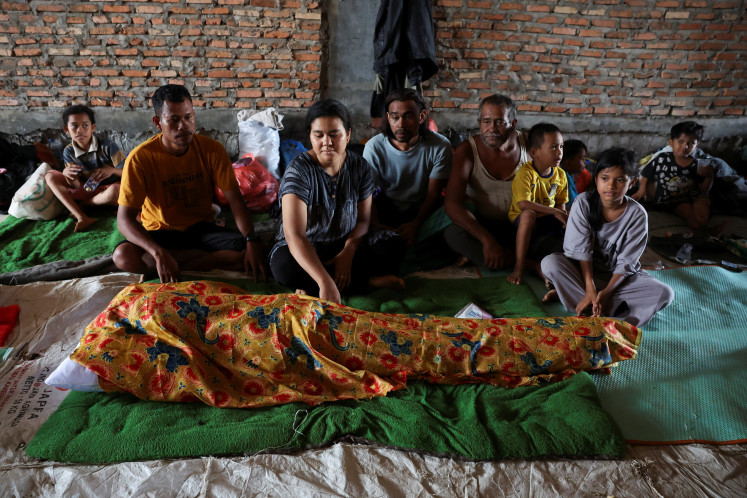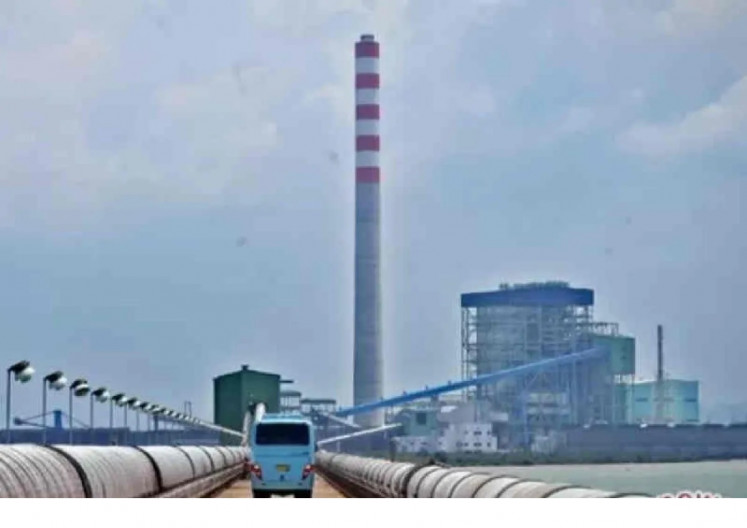Popular Reads
Top Results
Can't find what you're looking for?
View all search resultsPopular Reads
Top Results
Can't find what you're looking for?
View all search resultsAnalysis: Opportunities in maritime and fisheries sectors
There is a lot of potential in the maritime and fisheries sectors in Indonesia
Change text size
Gift Premium Articles
to Anyone
There is a lot of potential in the maritime and fisheries sectors in Indonesia. This potential spans the areas of capture fishery, aquaculture, marine resources, as well as the processing and marketing of such resources. There is currently a trend of rising fish consumption each year, in line with an increasing population. According to statistics from the Maritime Affairs and Fisheries Ministry, national fish consumption in 2014 amounted to 38 kilograms per capita per year, with average consumption over the past five years standing at 33.97 kilograms per capita per year.
Based on data from the Central Statistics Agency (BPS), the fisheries sector is showing increasing growth amid the current economic slowdown. In the first quarter of 2015, the gross domestic product (GDP) of the fisheries sector grew by 8.64 percent according to the BPS, up from 7.46 percent in the first quarter of 2014. In contrast, the Indonesian economy as a whole grew by only 4.71 percent in the first quarter of 2015, down from 5.21 percent in the first quarter of 2014. The GDP of the fisheries sector in the first quarter of 2015 also recorded greater growth than that of other sectors in the agriculture category, such as plantation crops (8.52 percent), livestock farming (5.06 percent), forestry and logging (1.24 percent) and food crops (-1.45 percent).
Data from the ministry indicates the growth of the fisheries sector is being driven by rising production of capture fisheries and aquaculture. For example, production from capture fisheries and aquaculture nationwide in 2014 was 6,200 million tons and 14,521 million tons, respectively, up 1.4 percent and 9.2 percent from 2013. In the five years from 2010 to 2014, the national production of capture fisheries and aquaculture grew by an average of 3.6 percent and 23.7 percent, respectively, per year.
The ministry's acting director general of capture fisheries stated that the first half of 2015 showed that the production of capture fisheries amounted to 2.96 million tons with a production value of Rp 59.301
trillion. This capture fisheries production consisted of 2,749 million tons with a value of Rp 54.721 trillion from seas and 214,790 tons with a value of Rp 4,579 trillion from open waters. In contrast to recent years, capture fisheries production in this semester suffered stagnation brought about by several factors, such as marine environmental degradation due to global climate change and the uncontrolled and excessive exploitation of fish which has resulted in reduced production of fisheries.
As for aquaculture, the acting director general of capture fisheries stated that aquaculture production in the second quarter of 2015 is predicted to fall by 10 percent to 20 percent compared to production in the first quarter of 2015 which amounted to 2.9 million tons with a value of around Rp 20 trillion. The decline will mainly stem from marine aquaculture which has been affected by temperature increases over the last three months that, in turn, have affected the reproductive systems of marine fish.
Although the amount of fish from marine aquaculture is predicted to fall, several other commodities in this sector are expected to enjoy some growth, especially seaweed. This is partly because the production of seaweed requires low rainfall. Seaweed is one of the major aquaculture commodities to serve as a mainstay in enhancing the production, economies and wellbeing of coastal communities. The development of seaweed cultivation is in line with the vision and mission of the Cabinet to turn Indonesia's maritime resources into a great source of contribution to the nation's economy in the future and, in doing so, turn Indonesia into an international maritime axis. Seaweed cultivation is also consistent with the three pillars of development, as derived from the Vision and Mission of the Indonesian President. These three pillars are Prosperity, Sustainability and Sovereignty. Furthermore, seaweed cultivation is one branch of aquaculture that does not cause pollution, does not require feed or chemical treatment, and uses simple technology.
Provisional statistical data from the Food and Agriculture Organization (FAO), issued in March 2015, stated that the production of Indonesian Eucheuma Cottonii seaweed in 2013 ranked first in the world, with as much as 8.3 million tons. As for Gracilaria sp. seaweed, in the same year Indonesia ranked second after China, with production of 975,000 tons. According to provisional data from the ministry, national seaweed production in 2014 totaled 10.2 million tons, a more than threefold increase from its 2010 production figure of around 3.9 million tons, with an average annual increase of 27.71 percent. This year the ministry is targeting aquaculture production of 17.9 million tons, to consist of 10.6 million tons of seaweed and 7.3 million tons of other farmed marine products.
From all this BPS and ministry data, it can be discerned that while the Indonesian maritime and fisheries sector is enjoying an upswing, there remain many opportunities to be harnessed both by traditional fishermen as well as businesspeople. This can be seen from the value of fisheries exports, which in 2013 stood at US$4.18 billion and in 2014 rose by 10.92 percent to $4.64 billion. Meanwhile, export volume in 2013 came to 1.26 million tons and in 2014 went up by 0.86 percent to 1.27 million tons. One factor behind this increase in exports was the result of efforts to eradicate illegal fishing so as to boost domestic fish production. Since the enactment of the anti-illegal fishing campaign, fisheries production volumes and values have been greater than ever.
To be able to further maintain, promote and even boost increases in exports from the marine and fisheries sector, the ministry has and will continue to implement various initiatives, such as accelerating the resolution of export barriers, enhancing the synergy between ministries and institutions, particularly that between the Directorate General of Customs and Excise and the Finance Ministry, aimed at improving the quality of export data by means of monitoring export declarations (PEB), exercising greater control over data recording in border areas, validating the recording of export data in cooperation with the
BPS, as well as expanding promotions and market access in non-traditional markets (outside the US, EU and Japan).
In addition, the ministry has also issued some regulations and circular letters to be used as guidelines for relevant fishermen and businesspeople. The following are a few of these ministerial regulations and circulars issued by the ministry: Maritime Affairs and Fisheries Ministry Regulation No. 56/PERMEN-KP/2014; Circular Letter of the Secretary-General of the Maritime Affairs and Fisheries Ministry No. 241/SJ/TU.210/III/2015; Circular Letter of the Director General of Maritime and Fisheries Resources Monitoring No. 3751/DJPSDKP/III/2015; and Circular Letter of the Secretary-General of the Maritime Affairs and Fisheries Ministry No. 581/2015, as a follow-up to the issues of Indonesian fishing vessels which are constructed abroad (foreign exports) and captured fish which are stored in cold storage or holds/refrigerators. This circular letter also contained directives for officials at the ministry on how to follow up on license applications submitted by various companies.
________________________
The writer is an analyst at the Mandiri Institute










